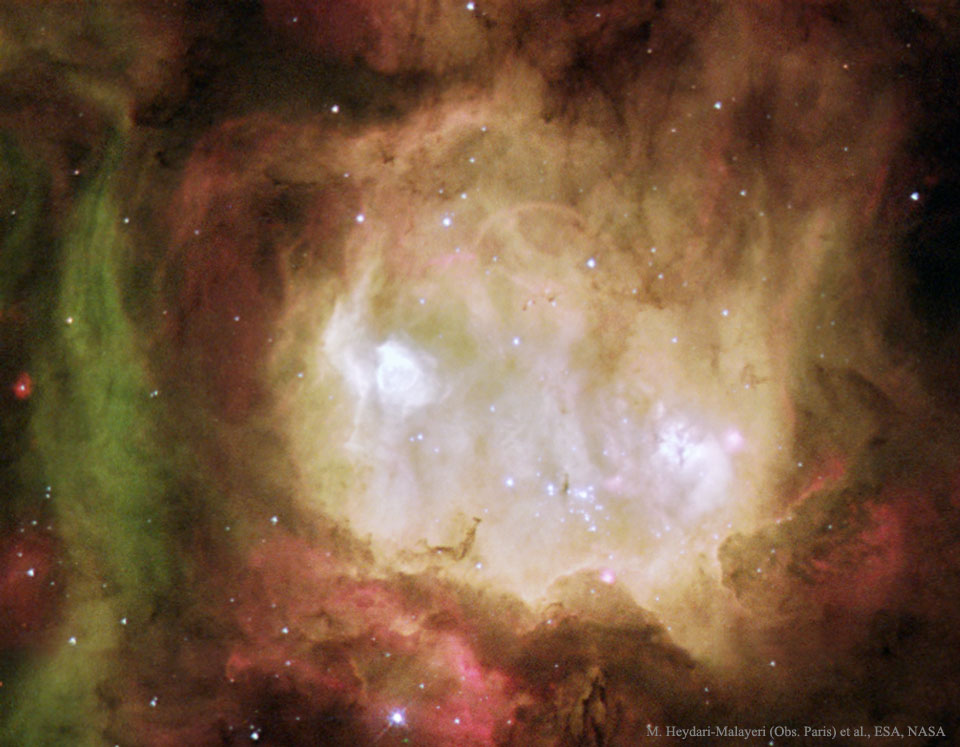Blog
Does the road to our galaxy’s center go through Monument Valley? It doesn’t have to, but if your road does — take a picture. In this case, the road is US Route 163 and iconic buttes on the Navajo National Reservation populate the horizon. The band of Milky Way Galaxy stretches down from the sky and appears to be a continuation of the road on Earth. Filaments of dust darken the Milky Way, in contrast to billions of bright stars and several colorful glowing gas clouds including the Lagoon and Trifid nebulas. The featured picture is a composite of images taken with the same camera and from the same location — Forest Gump Point in Utah, USA. The foreground was taken just after sunset in early September during the blue hour, while the background is a mosaic of four exposures captured a few hours later.

William Earl “Bootsy” Collins (born October 26, 1951 Cincinnati, OH) is an American musician, singer and songwriter.
Rising to prominence with James Brown in the early 1970s, and later with Parliament-Funkadelic, Collins’s driving basslines and humorous vocals established him as one of the leading names in funk. He later formed his own P-Funk side project known as Bootsy’s Rubber Band. He was a frequent collaborator with other musicians from a variety of genres, including dance music (Deee-Lite‘s “Groove Is in the Heart“), electronic big beat(Fatboy Slim‘s “Weapon of Choice“), and alternative metal (Praxis‘s Transmutation (Mutatis Mutandis)), among others. He is a member of the Rock and Roll Hall of Fame, inducted in 1997 with 15 other members of Parliament-Funkadelic.
more...Milton Nascimento (Portuguese pronunciation: [‘miwtõ nasiˈmẽtu]; born October 26, 1942) is a Brazilian singer-songwriter and multi-instrumentalist, known globally as one of the most influential and talented Brazilian musicians. Elis Regina once stated that “if God had a voice, it would be Milton’s.”
A unique and baroque voice combined with poetic lyrics, his music mesmerizes people all over the world. He has toured in North America, South America, Asia, Africa, and Europe. Nascimento is also highly praised in the music industry, having won five Grammy Awards, including Best World Music Album in 1997.
Milton Nascimento was born in Rio de Janeiro. His mother, Maria Nascimento, was a maid. As a baby, Nascimento was adopted by a couple who were his mother’s former employers; Josino Brito Campos, a bank employee, mathematics teacher and electronic technician and Lília Silva Campos, a music teacher and choir singer. When he was 18 months old, Nascimento’s biological mother died, and he moved with his adoptive parents to the city of Três Pontas, in the state of Minas Gerais.
more...Eddie Henderson (born October 26, 1940) is an American jazz trumpet and flugelhorn player. He came to prominence in the early 1970s as a member of pianist Herbie Hancock‘s Mwandishi band, going on to lead his own electric/fusion groups through the decade. Henderson earned his medical degree and worked a parallel career as a psychiatrist and musician, turning back to acoustic jazz by the 1990s.
Henderson was born in New York City on October 26, 1940. At the age of nine he was given an informal lesson by Louis Armstrong, and he continued to study the instrument as a teenager in San Francisco, where he grew up, after his family moved there in 1954, at the San Francisco Conservatory of Music. Henderson was influenced by the early fusion work of jazz musician Miles Davis, who was a friend of his parents. They met in 1957 when Henderson was aged seventeen.
more...Phil Leadbetter, an acclaimed American resonator guitar player died on October 14, 2021. Phil Leadbetter was born in Knoxville (Tennessee, USA) on October 14, 2021. He was one of the finest dobro players in the bluegrass scene and was voted Dobro Player Of The Year twice by the International Bluegrass Music Association. Leadbetter released many albums as a solo artist and as member of various well known bluegrass acts, including The New South and Grasstowne. Phil Leadbetter curated and appeared on Masters of Slide: The Spider Sessions, a collection of master slide guitar players.
Born in Knoxville, Tennessee, Leadbetter began playing the resonator guitar at age 12. He was a 1980 graduate of Gibbs High School in Corryton, Tennessee.
In April 2011, Leadbetter was diagnosed with Hodgkins Lymphoma, a form of cancer that attacks the lymph nodes. After return of cancer two more times, Leadbetter was diagnosed for a fifth time in June 2019, and in September 2019 became a five-time survivor on the new drug Opdivo. This is the same drug that Leadbetter had been given during clinical trials.
Leadbetter died in October 2021, after having contracted COVID-19
more...This jewel-bright Picture of the Week features the spiral galaxy NGC 2903. This image was captured using Hubble’s Advanced Camera for Surveys (ACS) and Wide Field Camera 3 (WFC3), which were installed on Hubble in 2002 and 2009 respectively. Interestingly, Hubble has observed this particular galaxy before, in 2001, when neither the ACS or the WFC3 had yet been installed. The 2021 image boasts higher resolution, which means that NGC 2903 is more finely detailed than in the 2001 image. The ACS and WFC2 collectively cover a wide range of ultraviolet, optical and infrared wavelengths, which means that the 2021 image also has superior wavelength coverage to that of its 20-year-old predecessor. The 2001 image was taken using the Wide Field Planetary Camera 2 (WFPC2), which was Hubble’s workhorse instrument from 1993 until 2009 when it was replaced by the WFC3. Hubble has a long and fascinating history of crewed service missions, which were performed in order to correct for imperfections in Hubble’s mirror, to update Hubble’s technical systems, and to remove old instruments and install new ones. One of Hubble’s most remarkable features is it’s incredible longevity, and this would not have been possible with the great success of the servicing missions. The juxtaposition of the 2001 and 2021 images of NGC 2903 — both remarkable images for their time — highlights the value of a stable, accessible platform in space that can reliably collect data, not only year after year, but decade after decade.

Earl Cyril Palmer (October 25, 1924 – September 19, 2008) was an American drummer and one of the inventors of Rock and Roll. He is a member of the Rock and Roll Hall of Fame.
Palmer was one of the most prolific studio musicians of all time and played on thousands of recordings, including nearly all of Little Richard‘s hits, all of Fats Domino‘s hits, “You’ve Lost That Lovin’ Feelin’” by The Righteous Brothers, and a long list of classic TV and film soundtracks. According to one obituary, “his list of credits read like a Who’s Who of American popular music of the last 60 years”.
Born into a show-business family in New Orleans and raised in the Tremé district, Palmer started his career at five as a tap dancer, joining his mother and aunt on the black vaudeville circuit in its twilight and touring the country extensively with Ida Cox‘s Darktown Scandals Review. His father is thought to have been the local pianist and bandleader Walter “Fats” Pichon.
more...James Edward Heath (October 25, 1926 – January 19, 2020), nicknamed Little Bird, was an American jazz saxophonist, composer, arranger, and big band leader. He was the brother of bassist Percy Heath and drummer Albert Heath.
Heath was born in Philadelphia on October 25, 1926. His father, an auto mechanic, played the clarinet, performing on the weekends. His mother sang in a church choir. The family frequently played recordings of big band jazz groups around the house. Heath’s sister was a pianist, while his brothers were bassist Percy Heath (older) and drummer Albert Heath (his youngest sibling).
During World War II, Heath was rejected for the draft for being below the minimum weight.
Heath originally played alto saxophone. He earned the nickname “Little Bird” after his work for Howard McGhee and Dizzy Gillespie in the late 1940s, during which his playing displayed influences from Charlie Parker (Parker’s nickname was “Bird”). He then switched to tenor saxophone.
more...Eddie Lang (born Salvatore Massaro, October 25, 1902 – March 26, 1933) is known as the father of jazz guitar. During the 1920s, he gave the guitar a prominence it previously lacked as a solo instrument, as part of a band or orchestra, and as accompaniment for vocalists. He recorded duets with guitarists Lonnie Johnson and Carl Kress and jazz violinist Joe Venuti, and played rhythm guitar in the Paul Whiteman Orchestra and was the favoured accompanist of Bing Crosby.
The son of an Italian-American instrument maker, Lang was born in Philadelphia, Pennsylvania, and grew up with violinist Joe Venuti. His first instrument was violin when he was seven. He performed on violin in 1917 and became a member of a trio. In 1920, he dropped the violin for banjo and worked with Charlie Kerr, then Bert Estlow, Vic D’Ippolito, and Billy Lustig‘s Scranton Siren Orchestra. A few years later, he dropped the banjo for guitar when he became a member of the Mound City Blue Blowers led by Red McKenzie. He recorded one of the first solos in 1924 on “Deep 2nd Street Blues”. His performances with McKenzie’s band drew attention, and he found many jobs as a freelance guitarist. Before Lang, the guitar hadn’t been a prominent instrument in jazz bands and dance orchestras.
more...Georges Bizet (25 October 1838 – 3 June 1875), registered at birth as Alexandre César Léopold Bizet, was a French composer of the Romantic era. Best known for his operas in a career cut short by his early death, Bizet achieved few successes before his final work, Carmen, which has become one of the most popular and frequently performed works in the entire opera repertoire.
During a brilliant student career at the Conservatoire de Paris, Bizet won many prizes, including the prestigious Prix de Rome in 1857. He was recognised as an outstanding pianist, though he chose not to capitalise on this skill and rarely performed in public. Returning to Paris after almost three years in Italy, he found that the main Parisian opera theatres preferred the established classical repertoire to the works of newcomers. His keyboard and orchestral compositions were likewise largely ignored; as a result, his career stalled, and he earned his living mainly by arranging and transcribing the music of others. Restless for success, he began many theatrical projects during the 1860s, most of which were abandoned. Neither of his two operas that reached the stage in this time—Les pêcheurs de perles and La jolie fille de Perth—were immediately successful.
After the Franco-Prussian War of 1870–1871, during which Bizet served in the National Guard, he had little success with his one-act opera Djamileh, though an orchestral suite derived from his incidental music to Alphonse Daudet‘s play L’Arlésienne was instantly popular. The production of Bizet’s final opera, Carmen, was delayed because of fears that its themes of betrayal and murder would offend audiences. After its premiere on 3 March 1875, Bizet was convinced that the work was a failure; he died of a heart attack three months later, unaware that it would prove a spectacular and enduring success.
Bizet’s marriage to Geneviève Halévy was intermittently happy and produced one son. After his death, his work, apart from Carmen, was generally neglected. Manuscripts were given away or lost, and published versions of his works were frequently revised and adapted by other hands. He founded no school and had no obvious disciples or successors. After years of neglect, his works began to be performed more frequently in the 20th century. Later commentators have acclaimed him as a composer of brilliance and originality whose premature death was a significant loss to French musical theatre.
https://www.youtube.com/watch?v=3wM8Ttz10TY
more...https://www.youtube.com/watch?v=ADuCbafqBDQ
more...Since the fifth century BC, Halloween has been celebrated as a cross-quarter day, a day halfway between an equinox (equal day / equal night) and a solstice(minimum day / maximum night in the northern hemisphere). With a modern calendar however, even though Halloween occurs next week, the real cross-quarter day will occur the week after. Another cross-quarter day is Groundhog Day. Halloween’s modern celebration retains historic roots in dressing to scare away the spirits of the dead. Perhaps a fitting tribute to this ancient holiday is this view of the Ghost Head Nebula taken with theHubble Space Telescope. Similar to the icon of a fictional ghost, NGC 2080 is actually a star forming region in the Large Magellanic Cloud, a satellite galaxy of our own Milky Way Galaxy. The Ghost Head Nebula (NGC 2080) spans about 50 light-years and is shown in representative colors.

more...
Anthony Cox (born October 24, 1954) is an American jazz bass player. He is known for his work with several leading musicians including Geri Allen, Dewey Redman, Dave Douglas, John Scofield, Pat Metheny, Gary Thomas, Marty Ehrlich, Ed Blackwell, Joe Lovano, and Dave King. He plays mainly in the post-bop, avant-garde, and traditional styles, though he is “versatile enough to work in any style effectively.”
Cox grew up in Minneapolis and attended college at the University of Wisconsin-Eau Claire. Peter Madsen wrote that Cox is “open to all kinds of great music from around the world” and that “his bass sound is full of beauty and warmth and his ability to accompany and still add very creative ideas into whatever music he is playing is remarkable. He is equally comfortable playing chordchanges with a Stan Getz or Kenny Wheeler or playing open music with a Dewey Redman or Geri Allen.
https://www.youtube.com/watch?v=11EsLd_Qi88
more...Willie James Mabon (October 24, 1925 – April 19, 1985) was an American R&B singer, songwriter and pianist, who had two number one hits on the Billboard R&B chart: “I Don’t Know” in 1952 and “I’m Mad” in 1953.
Mabon was born and brought up in the Hollywood district of Memphis, Tennessee. He moved to Chicago in 1942, by which time he had become known as a singer and pianist. He formed a group, the Blues Rockers, and in 1949 began recording for Aristocrat Records and then Chess Records.
His biggest success came in 1952 when his debut solo release, “I Don’t Know“, written by Cripple Clarence Lofton (who received no royalties),topped the Billboard R&B chart for eight weeks. It was one of the most popular releases of its era and was Chess’s biggest hit before the successes of Chuck Berry and Bo Diddley. It was also one of the first R&B hit records to be covered by a leading white artist, Tennessee Ernie Ford. Mabon’s original was played on Alan Freed‘s early radio shows and also sold well to white audiences, crossing over markets at the start of the rock-and-roll era.
Mabon returned to the top R&B slot in 1953 with “I’m Mad” and had another hit in 1954 with the Mel London song “Poison Ivy”. However, his career failed to maintain its momentum, and record releases in the late 1950s on various labels were largely unsuccessful. Releases in the 1960s included “I’m the Fixer” and “Got to Have Some”.
more...Saunders Teddell, or Saunders Terrell (or other variants, sources differ) (October 24, 1911 – March 11, 1986), known as Sonny Terry, was an American Piedmont blues and folk musician, who was known for his energetic blues harmonica style, which frequently included vocal whoops and hollers and occasionally imitations of trains and fox hunts.
Terry was born in Greensboro, Georgia. His father, a farmer, taught him to play basic blues harp as a youth. He sustained injuries to his eyes and went blind by the time he was 16, which prevented him from doing farm work, and was forced to play music in order to earn a living. Terry played “Campdown Races” to the plow horses which improved the efficiency of farming in the area. He began playing blues in Shelby, North Carolina. After his father died, he began playing with Piedmont blues–style guitarist Blind Boy Fuller. When Fuller died in 1941, Terry established a long-standing musical relationship with Brownie McGhee, and they recorded numerous songs together. The duo became well known among white audiences during the folk music revival of the 1950s and 1960s. This included collaborations with Styve Homnick, Woody Guthrie and Moses Asch, producing classic recordings for Folkways Records (now Smithsonian/Folkways).
more...More Posts
- The Cosmos with the Antares
- Charlie Watts Day
- Ahmed Jamal Day
- World Music with Mamady Keita
- Daily Roots with Leroy Smart
- The Cosmos with IC 5332
- Leon “Ndugu” Chancler Day
- James Cotton Day
- Willie Dixon Day
- World Music with Music Maya Aj
- Daily Roots with Horace Andy
- The Cosmos with Trapezium Cluster
- Stanley Clarke Day
- Andrew Hill Day
- World Music with Nico Kasanda
- Daily Roots with Hortense Ellis
- The Cosmos with M24
- Gilberto Gil Day
- Julian Priester Day
- World Music with Paco De Lucia